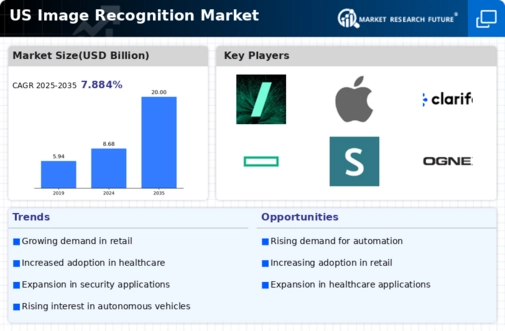Rising Demand for Automation
The image recognition market is experiencing a notable surge in demand for automation across various sectors. Industries such as manufacturing and logistics are increasingly adopting automated systems to enhance operational efficiency. This trend is driven by the need to reduce human error and improve productivity. According to recent estimates, the automation sector is projected to grow at a CAGR of approximately 25% over the next five years. As companies seek to streamline processes, the integration of image recognition technology becomes essential. This technology enables real-time monitoring and analysis, facilitating quicker decision-making. Consequently, the rising demand for automation is a significant driver for the image recognition market, as organizations strive to leverage advanced technologies to maintain a competitive edge.
Growing Need for Data Analytics
The image recognition market is being propelled by the growing need for data analytics across industries. Organizations are increasingly recognizing the value of visual data in making informed decisions. The ability to analyze images and extract meaningful insights is becoming essential for businesses aiming to enhance their operational strategies. The market for data analytics in conjunction with image recognition is expected to expand, with projections indicating a growth rate of approximately 20% annually. This trend suggests that companies are leveraging image recognition technology to gain a competitive advantage through data-driven insights. As the demand for effective data analytics solutions rises, the image recognition market is likely to experience substantial growth.
Expansion of Retail Applications
The retail sector is witnessing a transformative shift with the integration of image recognition technology. Retailers are increasingly utilizing this technology for various applications, including inventory management, customer engagement, and personalized marketing. The image recognition market is projected to reach a valuation of $10 billion by 2026, driven by the need for enhanced customer experiences. Retailers are employing image recognition to analyze consumer behavior and preferences, allowing for targeted promotions and improved service delivery. This expansion in retail applications not only enhances operational efficiency but also fosters customer loyalty. As the retail landscape evolves, the image recognition market is poised for substantial growth, driven by the increasing adoption of innovative solutions.
Advancements in AI and Machine Learning
The image recognition market is significantly influenced by advancements in artificial intelligence (AI) and machine learning technologies. These innovations are enhancing the accuracy and efficiency of image recognition systems, making them more accessible to various industries. The market is expected to grow at a CAGR of around 30% over the next few years, largely due to the integration of AI algorithms that improve image processing capabilities. As organizations seek to harness the power of data, the demand for sophisticated image recognition solutions is likely to increase. This trend indicates a shift towards more intelligent systems that can learn and adapt over time, thereby driving the growth of the image recognition market.
Increased Investment in Security Solutions
The growing emphasis on security and surveillance is a critical driver for the image recognition market. Organizations across sectors are investing heavily in advanced security solutions to protect assets and ensure safety. The market for security-related image recognition technologies is projected to grow significantly, with estimates suggesting a potential increase of 40% in the next five years. This growth is fueled by the rising need for real-time monitoring and threat detection. Image recognition systems are being deployed in various environments, including public spaces and corporate settings, to enhance security measures. As the demand for robust security solutions escalates, the image recognition market is likely to benefit from increased investments in this area.
















